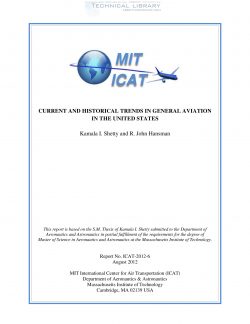ICAT-2012-6
- Version
- 216 Downloads
- 3.47 MB File Size
- 1 File Count
- March 5, 2017 Create Date
- March 5, 2017 Last Updated
Current and Historical Trends in General Aviation in the United States

General aviation (GA) is an important component of aviation in the United States. In 2011, general aviation and air taxi operations represented 63% of all towered opera- tions in the United States, while commercial aviation was responsible for 34% of those operations. It is clear that GA is a considerable component of the national airspace and airport system, even when only accounting for towered operations. Because of this significant presence, insight into GA is relevant to issues in air traffic manage- ment, air transportation infrastructure, and aviation safety, among others. Beyond the operational aspect, GA is of significance to society as a whole and to other stake- holders, including pilots groups, aircraft manufacturers, and the work force. In 2009, general aviation generated 496,000 jobs and its total economic contribution to the U.S. economy was valued at $76.5 billion. However, a comparison of general aviation's impact on jobs and on the economy between 2008 and 2009, shows a 20% decrease in jobs and a 21% decrease in total economic impact in the course of a year. There is also a significant decreasing trend in the active pilot population, along with steady decreases in GA flight hours and towered operations. The objective of this thesis is to explore the details of these changing trends and to determine what drives and what hinders general aviation activity in the country. A combination of data analysis and the development of a survey administered to general aviation pilots shed light on what has driven activity in the past on a national scale, what factors affect an individual pilot's level of activity, and what challenges the general aviation community faces in the future.
| File | Action |
|---|---|
| ICAT-2012-6 Current and Historical Trends in General Aviation in the United States.pdf | Download |

Comment On This Post